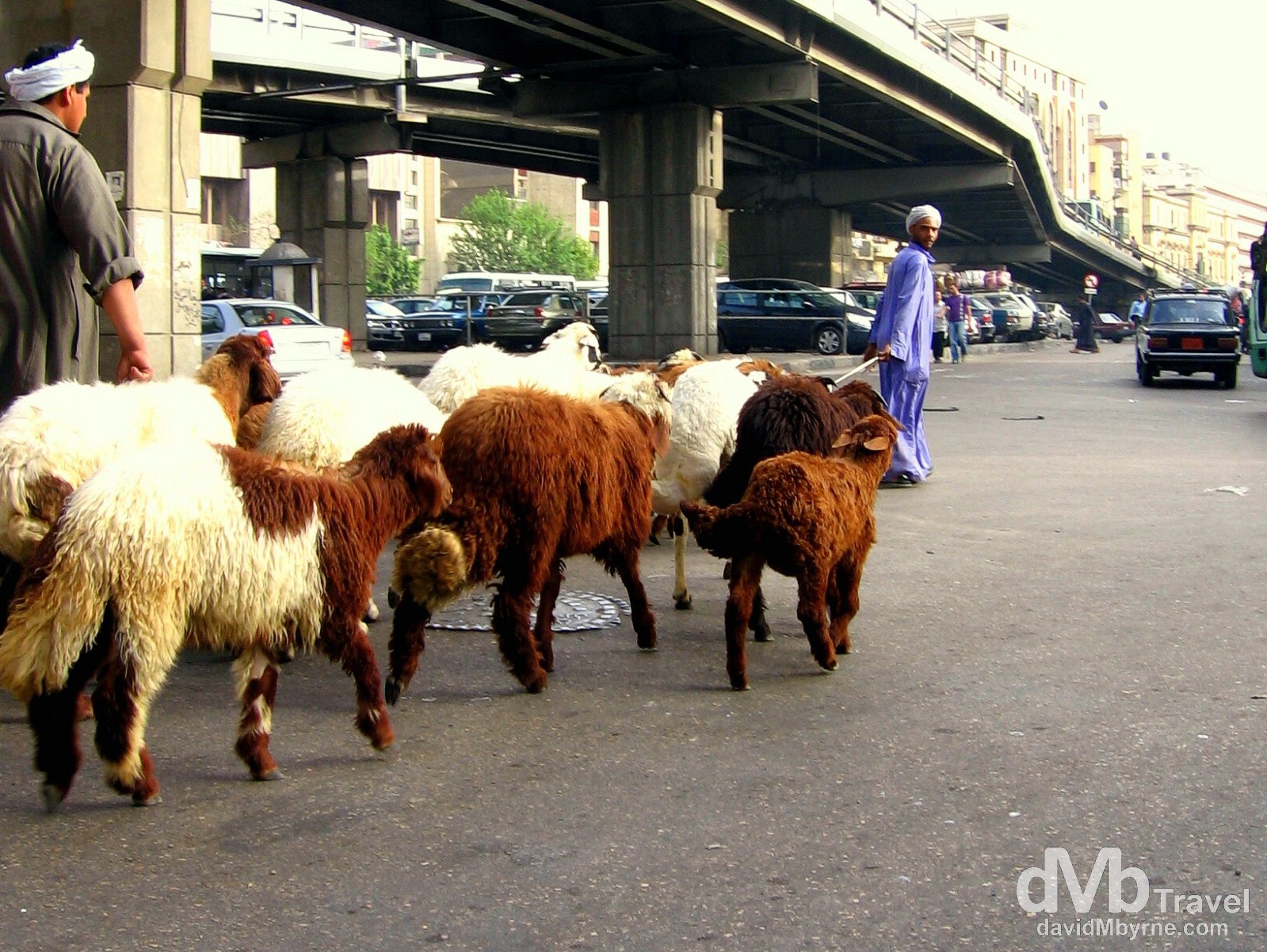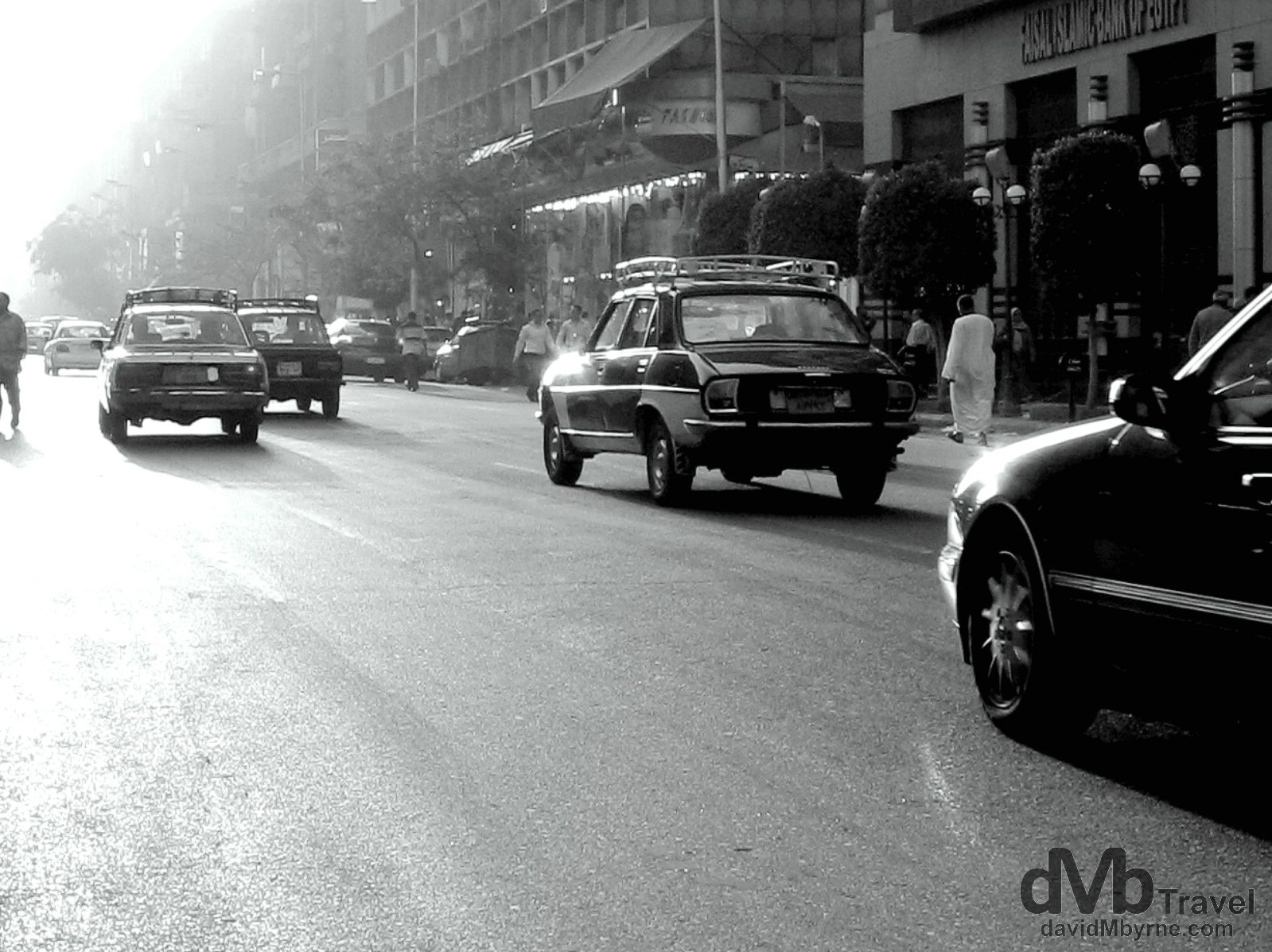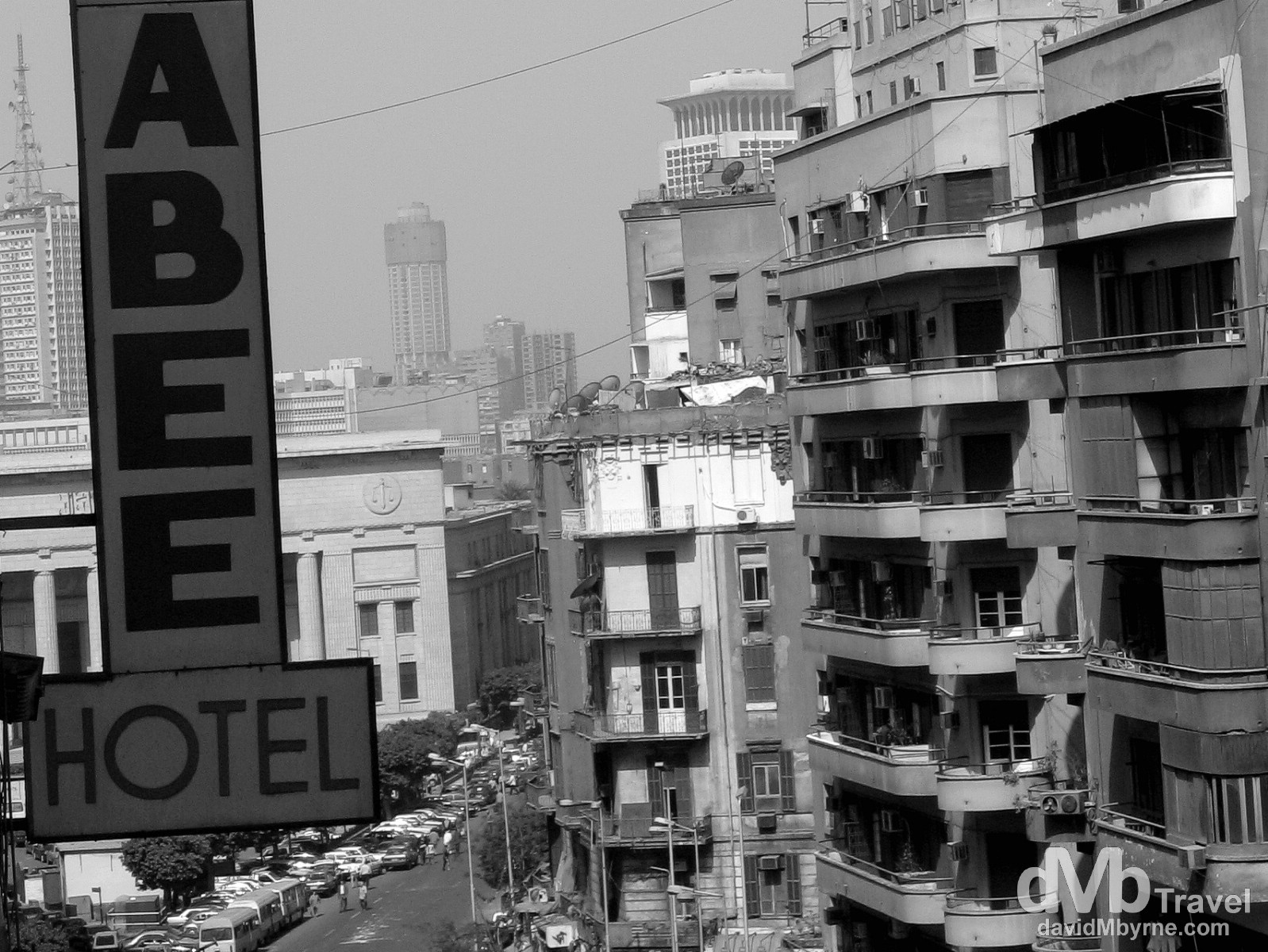I‘m finally getting use out of the Lonely Planet Middle East guidebook I bought way back when. I’ve flipped it open countless times since but when I flipped it open a few days ago in my hotel room here in Cairo it actually meant something. That was shortly after arriving in the city off a 4-hour flight from Dubai. And while the flight to get here with Egypt Air may have been routine, I certainly cannot say the same of Cairo itself, even with only two days of Cairo time under my belt. The city, founded c.3100 BC, is an agglomeration of half a dozen cities. The second largest city on the African continent (after the Nigerian capital of Lagos), it’s a huge, seething, polluted place crammed with – depending on what guidebook you read – anywhere from 11 to 18 million people, all of which seem to be either walking or driving its chaotic streets at the same time. It’s the greatest city in the Islamic world and the capital of the world’s most populous Arab country; Egypt’s population of 75 million, 96% of which are Muslim, accounts for 25% of world’s Arab population. And it’s hard work, even for a hard worker like me.
– Jan Morris, Destinations

Goat herding on the streets of Al-Azhar, Cairo. We took a quick introductory look around a section of the city shortly after arriving and it didn’t take long to realise that seemingly anything goes here on the streets of this city. The whole city feels like one big open-air market, bisected by always busy, always noisy streets full of beat-up buses, taxis, vans, & carts – if it has wheels and/or spews carbon monoxide you’ll find it on these streets. People sit on the side of the roads manning makeshift stalls that seem to sell anything from used radios to unused satellite dishes, books, tissues, frying pans, extractor fans. Anything really. Tea sellers move among all the madness with trays delicately balanced on their heads, people go about their business seemingly oblivious to their surroundings and locals jump on and off moving buses with alarming confidence & some sixth sense that tells them there isn’t another vehicle there to mow them down. Yes, it’s anything goes alright. Cairo, Egypt. April 9, 2008.
We’ve spent the last 2 days dealing with Cairo’s madness. This invariably involves taking your life into your own hands when crossing the street, responding to hundreds of “welcome!” greetings (being the nice boys we are we believe it is rude not to) and being constantly on guard against being ripped off. It’s tiring but it’s also rewarding and makes visiting Cairo a truly unique & unforgettable experience. We’re leaving the city tonight for the southern tourist mecca of Luxor and its famous Valley of the Kings. We’ll be back in Cairo in a few days, back to deal once more with its short-changing locals, migraine inducing streets and tourist-dollar siphoning attractions. We’re looking forward to Cairo, The Return. We’re just not too sure why.
______________________________________________________________________
Observations from the last few days.
· Egypt Air
I guess it was only appropriate that it was Egypt Air, Egypt’s national carrier, who had the honour of flying us from Dubai to Cairo. It was my first time flying with them. It was a good flight, even if they didn’t offer us a beer. By the way, Lonely Planet isn’t overly fond of the airline. According to them the Egypt Air service ‘isn’t particularly good’, its fleet is ‘in need of an upgrade, & generally you’ll do better flying with another airline.’ Whoops. Too late.
· DIY Visa
The first thing we did after arriving in the arrivals terminal of Cairo’s International Airport was get our visa and here’s hoping the simplicity of that procedure is an indication of how things work in Egypt. Handing over €10 gets you a sticker (the visa) which you best affix into your passport by the time you walk the few yards between the visa counter and the immigration check. I’ve never before fixed a visa in my passport; at least you get to choose what page it goes on.
· “Welcome!”
– The Rough Guide to Egypt
Egyptians are a very welcoming bunch of Arabs. No doubt about it. We’ve heard “Welcome!” shouted at us countless times over the last few days. But the country also has a (very) real & well-earned reputation for touts. Needless to say we’ve encountered a few over the last 2 days including very unofficial officials in the airport arrivals hall all eager to dispense to us bogus advice. We’ve heard ‘Where you from? more times than we care to remember too, with most, although not all, of the questions being posed by overly friendly strangers. They like to attach themselves to us for as long as it takes for them to get the message that we don’t actually want whatever unnecessary service it is they are offering. We’ve never actually tolerated them long enough to discover exactly what it is they are offering but it is invariably an overpriced tour, a similarly overpriced hotel room or an invite to their brother’s or uncle’s carpet/jewellery/craft shop. We have been approached by genuinely friendly locals although not many. It’s unfortunate but the approach we’ve adopted is to assume that anyone who approaches us does so with an angle and/or a motive. It’s just easier that way no matter what any guidebook might say on the matter.
· Check & double check
We’ve only been here two days but we’ve already lost count of the amount of times we’ve been short-changed. Even the guys behind the glass in the metro station, the ones wearing the very official looking uniform, have left us short. Count your change after each and every transaction and when you’re finished counting count again. We’d be surprised if you haven’t been gouged, our new favourite word.
· TT || Tourist Train
We’re going to Luxor this evening, a 10-hour overnight train trip of some 400 kilometres. The train we’re taking is one of only 3 trains approved to carry foreigners – for security reasons the 3 trains are patrolled by plain clothes officers due to the ever-present, albeit rare, threat of a terrorist attack. Our ticket for a reclining seat cost us €15 each, a lot less than the €45 it would have cost us for a berth on the so-called ‘tourist’ train that plies the same route. It’s one of the few occasions so far that we’ve been able to avoid being, well, gouged. It takes a bit of work to avoid buying a ticket for the tourist train (train staff will assume you, as a westerner, will want a berth on the ‘tourist’ train) but the effort will save you €30, a lot of money in Egypt and €30 others will, no doubt, try to extrapolate from you.

Late afternoon traffic on 26th of July street, Downtown Cairo, Egypt. April 10, 2008.
· Raping & Pillaging – The Return
Egypt is cheap, especially if, like us, you’re arriving from the money pit that is the Arabian Peninsula. One Egyptian pound (EGP) (€0.12) for both of us for a 40-minute bus ride from the airport to downtown Cairo says it all. This revelation pleased Pat & brought from him the proclamation that – and just like we did in India, Nepal & China over the past weeks – we’re once again raping and pil… well, you know. Yep, Egypt is definitely more of a piggy bank, less off-shore bank kind of location.
· Arabic headaches
I commented on the difficulties of deciphering the Arabic script when in Oman but it wasn’t until we got here to Cairo that it began to cause us headaches. In Arabic a zero is written as a dot, a 2 looks like a mirrored 7, a 4 a mirrored 3, a 5 a zero, a 7 looks like a V & an 8 looks like an inverted V. Only the 1 & 9 look familiar to us Arabic simpletons. We were told by the information desk in the arrivals hall of the airport to get the 357 bus to downtown. We eventually found it but boy did we ever have fun doing so.
· Early risers
We seem to be out of bed alarmingly early these days. For some reason we’re awake by 6 a.m. and up & out by 8 a.m. And no it has nothing to do with the seemingly incessant beeping of car horns, the definitive Cairo soundtrack, even at 6 a.m. But early morning noise pollution aside, Cairenes seem to be a late to rise, late to bed sort of people. Shops and businesses don’t open until 10 a.m. or 11 a.m. but will be jam packed with consumers well beyond what even we deem a late bed time.

A section of Cairo, Egypt, as seen from the restaurant of the Scarabee Hotel in downtown Cairo, our home in the city. The no-frills hotel does the job; it’s central & cheap although the mattresses look and feel older than Cairo itself. Cairo, Egypt. April 10, 2008.
· Eating like an Egyptian
We’re loving the basic but filling Egyptian breakfast served to us here in the Scarabee Hotel. Hot fuul (boiled fava beans mashed with lemon juice, olive oil & chopped chillies) mopped up with flat bread and washed down with tea (no milk, just sugar and mint leaves) goes down a treat and keeps us going for hours. I guess it’s not surprising that they do it – fuul – so well here given the fact that it’s their national dish.
· Anti Pedestrian
I’ve already mentioned how chaotic the streets of Cairo are so it’ll come as no surprise to learn that they are not very pedestrian friendly: Traffic lights are just a decoration, ones that look so much prettier at night; pedestrian crossings are, at best, a curiosity to Cairo motorists; and, just like in India, the horn is the most essential part of any road-going vehicle. We have it on good authority that two beeps means “I’m alongside and about to overtake”; a single long blast warns “I can’t (won’t) stop and I’m coming through!”; whereas extending your hand, fingers raised and tips together, is the signal for “Watch out, don’t pass now”; & spreading your fingers and flipping them forwards indicates “Go ahead.” Our guidebook advises that one should cross the road using a local as a buffer between you and the oncoming traffic (most likely a 1980s Peugeot or Lada) and to ‘never ever hesitate once you begin to cross.’ Thanks for the advice Lonely Planet but we are of the impression that, & as nerve wrecking as crossing the road here is, the locals don’t actually want to hit you. That coupled with their avoidance moves and your non-hesitance (very important) should see you to the other side safely enough. If not, then at least the local buffering you from the traffic should take the brunt of whatever transpires. Good luck, and may God be with you.
· Drinkies
If I ever open an off-license/liquor store (now there is a thought) I’d call it Drinkies, just like the state off-license here in Egypt. We’d almost given up on finding beer in Egypt until we joyously laid our eyes on Drinkies and their wall of Stella beer bottles (Stella is Egypt’s ‘Authentic lager beer, brewed since 1897’ and no, it’s not the same as the better known, in Europe at least, Belgium Stella). EGP 4.5 (€0.55) for a 500 ml bottle means Drinkies is, for us, the best tourist attraction in the city. We’re not on first name terms with the Drinkies guys just yet but we’re getting there.
· Egyptian Museum || The good & the not so good
We took a looked at a few of the 100,000 antiques and statues that are housed in the Egyptian Museum earlier today, some of which are, get this, over 4,600 years old. 4,600 years old. Now that’s old, mindbogglingly old by anyone’s standard. Most of the statues looked like they were carved yesterday but have actually been around since about 2600 BC. Amazing. There is no doubting the historical significance and quality of the antiquities and artefacts from every period of ancient Egyptian history on display in the museum – Tutankhamen’s funerary mask and sarcophagus are indeed breathtaking. All that said, the museum itself is a dark, badly laid out and wholly inadequately labelled zoo. Our advice is to come prepared (rested, with patience and sharp elbows) and informed to get the best out of a visit to what is supposed to be one of the best museums in the world.
· North to… Damascus
Pat was reading our Middle East guidebook (by the way Lonely Planet, is Egypt really in the Middle East?) last night when he piped up and proclaimed that he wanted to go to Damascus, the Syrian capital. It wasn’t part of the original Middle East itinerary but seen as we don’t actually have a Middle East itinerary then we should be able to squeeze it in somewhere.
______________________________________________________________________
